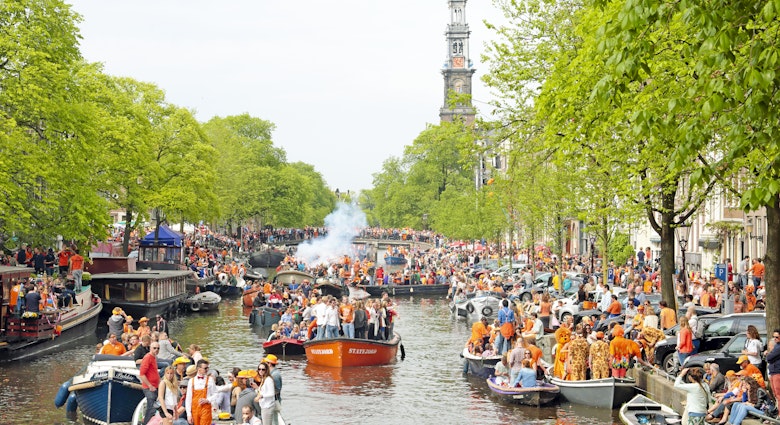Next year, visiting Amsterdam will get more expensive.
The Dutch capital has confirmed a rise its tourist tax on hotel rooms to 12.5% in 2024 – making for the highest tourist tax in Europe. The increase will apply to travelers staying overnight in hotels, short-term rentals or guesthouses, and affect those visiting on cruise ships, too.
So what is behind the city’s decision? And how will that affect your traveling plans?
What the change means for your hotel bill
Amsterdam’s current tourist tax stands at 7%, and is set to increase to 12.5%. This means that next year, the tax on the average room rate of €175 ($186) per person will rise from $15.25 ($16.18) to €21.80 ($23.12) per night. In comparison, Barcelona's tourist taxes average about €2.25 per person per day, while in Paris you can generally expect to pay about €4 per person, per night.
Additionally, the tax for cruise-ship passengers will go up from €8 to €11 ($8.48 to $11.66) per visitor, per day.
Tourism taxes have become commonplace in Europe. Still, in contrast to many other cities, Amsterdam levies its tourist tax as a flat rate per day, and as a percentage of the accommodation cost, payable upon each visitor’s arrival at their hotel. This unique approach can sometimes lead to confusion and unexpected expenses.

Why is Amsterdam hiking its tourist tax?
In 2022, Amsterdam welcomed 17 million tourists, a number projected to grow to over 20 million in 2023. Given the city’s population of nearly 900,000, it’s no surprise that there’s a growing aversion to this number of visitors. The mass-tourism trend is a significant concern for residents and businesses, expressed largely through complaints about noise and unruly behavior. These concerns are underscored in Amsterdam’s Tourism Policy, which explicitly acknowledges the need to address tourism-related nuisances and disturbances. The city is actively working to prevent the kind of tourism that compromises the quality of life for its residents.
Ivan Saprov, founder of US-based travel-tech company Voyagu, supports the idea that popular tourist destinations like Amsterdam have a legitimate reason to impose taxes on every visitor. “Amsterdam is also grappling with the challenge of balancing its tourist appeal and maintaining its unique charm,” he says. “There’s an ongoing debate on whether the city truly needs such a high influx of tourists. A proposal to relocate the famed Red Light District is indicative of this struggle.”
A major rationale for the tax is a desire to change how visitors see Amsterdam. Famous as a free and open city, Amsterdam has been advertised by some businesses as a place of “unlimited possibilities,” creating a sense that in the city, anything – or any behavior – goes.
City officials are therefore seeking to promote and encourage products, activities and services that contribute positively to the city and its residents. The effort has included banning bachelor parties and organized pub crawls that cause disturbance, implementing earlier closing times for bars and clubs, and introducing a ban on smoking cannabis on the street in parts of the city center.
This year, tourism officials launched the “Stay Away” campaign to discourage young tourists from visiting Amsterdam to engage in excessive partying. The campaign seeks to raise awareness about the impact of their behavior and promote responsible, respectful tourism.

Where will the new tax revenues go?
The city’s government says the extra revenue from the tourist tax hike will be invested in neighborhoods and districts where the need is greatest. The funds will address local challenges, support green and recreational spaces, and support such community resources as youth centers.
A principal goal of the higher tourist tax? To impose no financial burden on the city’s residents. Hester van Buren, Amsterdam’s deputy mayor for finance, emphasized this point, stating that residents are already struggling with inflation. As a result, next year the tax increase will not affect residents but will target only tourists instead.
“Visitors will thus help to pay for the city to carry out its tasks,” Van Buren says. “This allows us to address the consequences of overtourism and direct additional resources to keep the streets clean and solve acute problems in neighborhoods and districts.”

Saprov highlights the potential for tourism-related taxes to fund sustainable tourism initiatives, including conservation efforts and community-based infrastructure projects. He notes, “Amsterdam tourist tax is further increasing to fund the extra contribution to the city’s responsible growth, more green and sport space to become more sustainable.”
Not everyone supports this tax increase, however, since it will raise hotel bills. Erwin van der Graaf, an executive at Accor, has written that the tax was unfair to the hotel and cruise sectors. He asked why “the significant revenues from tourist tax are not dedicated to mitigating the effects of tourism and invested in more capacity for garbage collection and law enforcement, for example. To date, tourist-tax revenues are added to the generic budget of the city, and we can only guess what these revenues are spent on.”
Amsterdam Maths
How do average costs in Amsterdam play out? Be prepared for some eye-opening expenses. On average, a Friday-to-Sunday trip to Amsterdam can set you back around €550 ($579.18). Hotel costs alone can amount to €418.24 ($440.43) per person (and will rise considerably once the new tourist tax is added) and daily food expenses can add approximately €33 ($34.75) per day, marking a 9% year-on-year increase, according to Amsterdam Tips. Don't forget to factor in expenses like train tickets from the airport, bike rentals, and admission to the MOMA museum, which can tally up to another €50 ($52.65).












